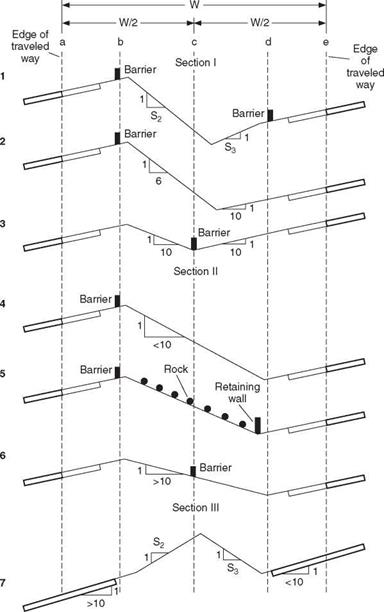Upgrading Bridge Railing Systems
The first step in an upgrading project is to identify potentially deficient systems. Bridge railing designs prior to 1964 are particularly suspect. Strength and performance should be documented. Verify critical details such as base plate connections, anchor bolts, material (strength, toughness, and condition), welding details, reinforcement development, etc. Open-faced railings may cause snagging. Curbs or sidewalks adjacent to a railing may cause an impacting vehicle to vault or roll over. Approach transitions may be inadequate.
Retrofits can be developed to address inadequacies. When possible, use crash-tested designs in such updating. One common improvement is to rebuild the approach barrier and transition to current standards, continuing the metal-beam rail element, for example, across the structure to provide continuity. If a curb is in place, a retrofit railing can
|
FIGURE 6.36 Barrier placement for sloped medians. (From Roadside Design Guide, AASHTO, Washington, D. C., 2002 and 2006, with permission) |
often be blocked out to minimize rollover and ramping. Some specific retrofit concepts are discussed in the following.
Concrete retrofit (safety shape or vertical). The concrete safety shape can be used most effectively when it can be constructed in front of an existing railing that can remain in place. A vertical-faced concrete shape creates an effective barrier when added on top of and flush with an existing safety curb. The structure must be evaluated for the extra dead load imposed, and for the development of the required anchorage to resist impact forces.
W-beam and thrie-beam retrofits. A partial solution sometimes used is to continue an approaching W-beam or thrie-beam roadside barrier across the bridge. It may not bring the bridge into full compliance with AASHTO criteria, but may be satisfactory as an interim solution, particularly on low-volume roadways. Adequate anchorage is provided by the continuous system. Gradual stiffening in the transition area is advised to avoid snagging.
Metal post-and-beam retrofit. Where a sidewalk is present, a steel post (S shape or channel shape) can be anchored to the top and a pair of steel tubes attached to the roadway side to provide a smooth traffic barrier between the sidewalk and the roadway. The tube elements must be in line with the face of the curb. The postattachment can be designed to resist the impact loads, or a yielding design can be developed to minimize possible bridge deck damage. The existing bridge railing on the outside of the sidewalk can be adapted to a pedestrian railing.







Leave a reply